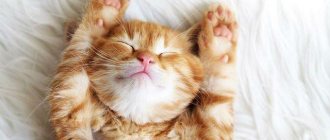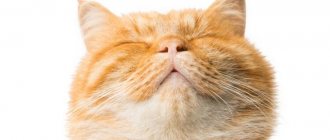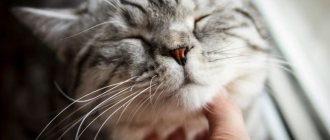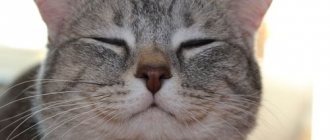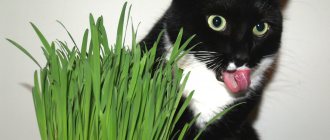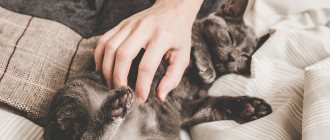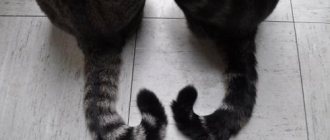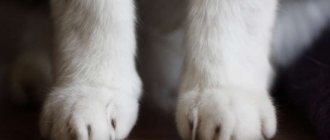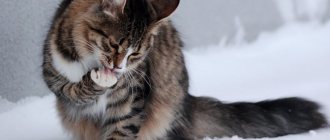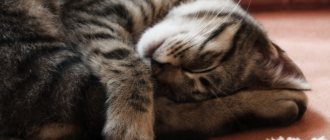The purring of a cat is one of the most pleasant sounds for an animal owner. But the mechanism of origin and its properties still remain a mystery. Even felinologists cannot say exactly when cats learned to purr. It seems that the hoarse vibrating sound relates exclusively to the expression of emotions, but this is not so.
Let's find out what a cat purrs about and how to react to this behavior of a pet.
What is purring and who, besides a cat, makes it?
It is believed that a cat's purring calms both the pet and others. Although objectively this acoustic vibration can also be an alarming signal.
Not only domestic cats purr, but also some inhabitants of the wild world:
- Gorillas, elephants and squirrels can rumble. The desire to express pleasure sometimes appears during food.
- Hyenas, foxes and bears with badgers also periodically grumble and make a sound similar to the purring of a cat.
- A team of predators (from lynx to tiger) is “carried away” by purring singing.
A person hears all this motley “company” only in the zoo from a safe distance, but the sounds of cats at any volume level can be fully enjoyed at home.
If we formulate it without emotional connotation, then purring cats produce a vibrating sound of varying duration in a predominantly low tonal register.
Although there is some gradation in the cat’s vocal roulades, it relates more to the place and circumstances - the cat’s purring changes even depending on the mood of its owner, on whose lap it is located.
This is interesting! Even musicians who can imitate the voice of any animal have not been able to create with their instruments a sound similar to the way cats purr next to a person.
Benefits of “cat songs”
“Cat songs” are useful not only for their authors, but also for listeners. They are helping:
- normalize the emotional state, which is especially useful for owners with nervous disorders;
- strengthen bone tissue and reduce pain;
- improve blood circulation in the brain;
- lower blood pressure or pulse that is too high;
- enhance the regeneration of tissues of the gastrointestinal tract;
- reduce the likelihood of stroke and heart attack.
People who live with furry pets live 4.5 years longer than those who do not have pets. There is also a relationship with allergen resistance. Children who live with a mustachioed pet from birth are less susceptible to respiratory diseases and rarely suffer from asthma.
Mechanism of purring (vocal cords, diaphragm, vascular theory)
One of the options for the formation of unusual sounds that representatives of the cat family make relates to the work of the respiratory organs, muscles in the larynx and vocal cords.
Studies using an electromyograph (a device for studying bioelectrical muscle potentials) have shown the mechanism of a cat's purring to be the use of vocal folds or laryngeal muscles. By rapidly alternating expansion and contraction of the sound passage, they cause rhythmic continuous vibrations of air in the inhalation-exhalation cycle.
It is in this cycle that the characteristic rumbling of a cat is born. The hypothesis does not illustrate all the features of the occurrence of noise, and therefore remains one of the puzzles in a puzzle that has not yet been solved.
Another failed discovery is the launch of the mechanism through the lungs and diaphragm. Observers came to this conclusion when they compared the cat’s purring and its breathing pattern. But they were never able to explain the entire line of behavior, from managing desire to its implementation.
Blood pressure was also not forgotten. They checked how it circulates through the vessels and even suggested the presence of hemodynamic processes - purring is formed as blood moves through the chest. No irrefutable evidence has been found, but at the level of rumors, this hypothesis is being discussed among cat lovers.
The next point of serious research is the hyoid bones and the degree of their hardening. It was noticed that animals cannot both purr and growl at the same time. Therefore, purring cats were enrolled in one group, and roaring cats in the other.
A characteristic feature of the first (including domestic ones) is a completely ossified ligament of the hyoid bones, while in representatives of the second group this property is partially expressed. The exception is the snow leopard. He can purr, like a cat next to a person, but his hyoid bones are not hard.
The most reliable option explaining purring is neurophysiological. A neural network oscillator was discovered in a cat's brain. This phenomenon is complex and even in humans has not been fully studied. Its job is to cause brain waves, which cause the nervous tissue to generate oscillatory activity. These impulses seem to control the hyoid bones, and they, in turn, cause the vocal cords to vibrate.
This is interesting! Cats purr with both their nose and mouth at the same time. At the same time, the body resonates so much that it is impossible to listen to the work of the heart or lungs.
The benefits of purring
There is a theory that purring can cause cats to produce a hormone that helps strengthen and grow bone tissue. Since most of the time the animal is passive, it needs restoration of the musculoskeletal system.
Cat purrs calm and relax people, helping relieve stress and lower blood pressure. The sound of purring is at a frequency of 20 to 44 Hz. It is capable of starting healing processes in humans, similar to ultrasound treatment.
One theory says that cats are able to treat gastritis, colitis and other gastrointestinal diseases in their owners with their purring.
The main reasons for a cat's purring
The most common causes of cat purring are:
- The animal purrs when asking for food.
- Demonstrates mood (joy, boredom, gratitude, etc.).
- Cats purr when they want to attract their owner's attention.
- It is believed that even fear stimulates the appearance of a vibrating purr.
- Pain relief and relaxation, for example, a cat may make a purring sound during labor.
Little kittens purr literally from the moment they are born. Sometimes this skill comes to them later, and some do not master the “vocal” art until the end of their days. But the presence or absence of this quality depends on the breed and other individual reasons.
Specifics of sounds made by cats
A cat purrs when it feels pleasure and more.
Many owners of furry pets have probably wondered why cats purr. In order to communicate with people or other animals, cats use various types of communication. Rumbling is one of them. A pet can show its mood through various gestures, the position and vibration of its tail, and also by making sounds.
Why do cats purr next to a person (when you pet them, they crush them with their claws and lie on their owners)
The gift of healing ailments belongs to the most mysterious section of the cat encyclopedia. The point, apparently, is in the frequency of sounds made and not only in them.
- Cats purr in the range of 20 to 150 hertz (Hz), a very comfortable tonal range that does not cause negative emotional aversion.
- Purring calms and helps to relax - if the cat is comfortable, then the owner has nothing to worry about.
- Often, cats lie on their owners and, when petted, start a quiet, monotonous “song.” Felinologists believe that the vibration of their body and the low sound of purring (20-50 Hz) have a beneficial effect on the condition of bones and joints. And higher tones can heal skin and muscle tissue.
- It has been noticed that animals “feel” injured areas on the human body - the cat purrs, lies down on the sore spot, and after a while the owner feels better.
Most likely, cats purr and lie on their owners, thanks to the natural instinct to settle in the warmest place. Inflamed areas of the body have an increased temperature, so the pet chooses them instinctively.
Even traditional stomping (with or without claws) can be considered a massage, but scientists attribute this ability to a genetic memory of preparing a den for sleep.
What does a cat's purring mean?
Previously, it was believed that this is how animals communicate with each other and humans when they are stroked. However, “mur-mur-mur” is not only a means of communication and a way to express pleasure.
Method of communication
Kittens begin to purr already in the first days after birth. This is how they help mom find herself and feed her. With a person, everything works about the same. Animals wake people up, butt and purr loudly in the morning, especially if they spend the night in another room. “Good morning, master! It’s time to get up and feed me.” If your pet loudly “sings songs” in the kitchen (or where you usually feed your pet) and curls under your feet, meowing periodically, this is a direct hint of a desire to snack.
Surely you have noticed more than once that pets greet you stormily from work. At this moment, you can also hear a joyful “mrrr”.
Purring, the cat greets its human.
In relation to relatives, everything works exactly the same: a quiet sound indicates location. He warns others about a benevolent and good-natured attitude. This is also how animals encourage each other. Some scientists have noticed that wounded cats lie down next to each other.
Expression of pleasure
A satisfied cat - what could be more pleasant for the owner? Pets can actually express pleasure and even gratitude from tasty food, a secluded bed and warmth. Many pets love affection, and with the help of purring they express pleasure from stroking and scratching.
In combination with paw stomping, purring indicates peace and love. This means that your pet completely trusts you, is happy and feels as calm as she does next to her mother. After all, kittens’ little paws make “massage” movements to get more milk. Apparently, the memory remains with the animal forever, and pops up in moments of good mood. And besides, in this way the cat “marks” the owner.
Connection with nutrition
Remember that a kitten purrs so that the cat notices and feeds it? Echoes of this mechanism can be seen in the fact that many animals rumble when they eat. Perhaps from pleasure. Especially if it is SUPERPET - a species-typical food for cats and dogs according to the BARF system, developed by veterinarians and nutritionists. It replicates the diet of predators in nature: 98% consists of raw meat without heat treatment, flavor enhancers and preservatives. Biologically appropriate nutrition normalizes digestion, prevents urolithiasis, kidney disease and other ailments. And how delicious it is! Pets can only purr with pleasure.
How to determine by purring what a cat wants
The meaning of a cat's purring depends on the animal's mood and health.
- He rubs against his legs, purrs and arches his back - he greets and attracts attention.
- It rumbles as soon as the owner is in the kitchen, next to food - he wants to eat.
- She settled down next to the owner somewhere on the sofa, purred, demanding affection.
- It bends over, stomps in one place and purrs endlessly - probably the animal is in pain.
- The unreasonable purring of a cat that is resting means that it has found a comfortable place for itself.
Which organs are responsible for a cat's rumbling?
Sometimes you may come across the statement that if a cat purrs, it does so either through its nose or through its throat. This is not entirely true: the brain is the main organ that causes cats to purr. Of course, the sounds themselves are produced by the vocal cords, which vibrate due to the movement of the vocal muscles located in the larynx. However, without a corresponding signal from the brain, the muscles will not begin to move on their own. That's why cats never rumble or purr for no reason; there must be something that spurs their brain to reproduce the command to “sing,” for example, seeing a sparrow outside the window or inhaling the aroma of fried fish.
What to do if your cat doesn't purr
Arbitrary options for the appearance or absence of “musical” abilities in cats are possible:
- Volume. Some cats purr in a barely audible voice.
- Genetics. The English Devon Rex does not purr itself, and does not teach its children to do so.
- Mood. A purring cat can remain silent for a long time. The reasons are different - from resentment towards the owner to jealousy towards others.
Vibration and sound, typically signifying the purring of a cat, is an optional sign of mood, breed or attitude towards a person.
Do big cats purr?
We have said more than once that the anatomy of a domestic cat is no different from the structure of a wild one. From a structural point of view, the gastrointestinal tract has not changed over millennia of evolution. What about neurophysiology and psychology?
Small cats - caracals, lynxes, cheetahs - purr like our domesticated pets. Although, of course, more often they hiss. Leopards, lions, panthers and tigers do not purr in the usual sense - they rather roar and make bass sounds. Their purr is more like a roar. But predators definitely use these techniques to communicate, when consuming food and expressing pleasure. There are videos online of cheetahs, tigers and pumas purring.
The most purring breeds
Until now, no pattern has been identified that explains the desire of cats to purr. Owners are inclined to the theory of sociability - the more sociable the animal, the more talkative it is. This means that the cat that purrs is one that wants to spend time with its owner. Pedigree and street cats have equal chances here.
As for the volume level, its maximum is 20 decibels, which is quite comfortable for human hearing. For comparison, street noise is 2.5 times louder.
This is interesting! The mongrel cat Smokey from England became famous for her outstanding purring - she purred 68 dB, was included in the Guinness Directory, and at the same time forced her owner to move away from her neighbors.
Why does he purr when you pet a cat?
Don't be surprised if you pet your cat for a long time and he will start purring. This is connected precisely with receiving positive emotions. The animal likes such stroking, it calms it down. Accordingly, the cat makes a characteristic sound. Sometimes pets can come to their owners, lie down next to them and purr for no apparent reason, even if you don’t pet them. This is connected precisely with the desire to improve health.
Often cats lie down near the area that is sore. Perhaps these are chronic diseases. It is at such places that cats lie down, lean against them and purr. In this way they try to cure their owner. A cat may purr for the simple reason that it is hungry or wants to go for a walk. Accordingly, in this case, the nature of the purring will be different.
Petting the cat
Timbre of purring
Purring can vary in intensity and timbre. By the volume of a cat's purring, one can understand and determine the emotional mood of a mustachioed pet.
Scientists distinguish several types of purring:
- A dissatisfied loud purr signals pain.
- If a cat is nervous, its quiet rumbling gradually intensifies and turns into a heart-rending meow. When experiencing stress and discomfort, the cat wags its tail, purrs and bites at the same time.
- With loud rumbling sounds, a nursing cat makes it clear to humans or other animals not to approach its offspring.
- A monotonous, calm, loud purring is a sign that the cat is feeling good and comfortable.
- Gradually subsiding rumbling means that the cat is gradually losing interest in what is happening. If the cat has stopped purring, she has received a portion of affection, a treat, is in a calm state or begins to fall asleep.
Important! The way cats purr is completely independent of breed, genetic, and hereditary factors. The volume, timbre, and tonality of the sounds produced are individual for each animal and depend only on external factors and the mood of the mustachioed pet.
A quiet, gentle purring indicates that the cat is in an excellent mood and is experiencing positive emotions. A quiet, calm purring, which may be accompanied by light biting, can be heard if you caress a cat or pick it up. The pet is satisfied and thanks you with such sounds.
If a cat purrs quite loudly, this may mean that the animal is alarmed or worried about something. It is possible that the cat is in pain or is experiencing discomfort.
Cat purring - real sound therapy
We have already mentioned that cats often lie down on the owner’s sore spot and begin to purr. An animal can, for example, lie on the owner’s legs if they are “whining” about the weather. Or even lie on your head when the owner is tormented by a migraine. What does this mean, can pets really heal? It turns out that the purring of cats is therapeutic sound therapy.
Photo: Scottish Fold kitten | Dreamstime.com
A measured, quiet sound calms frayed nerves no worse than the sound of rain or the sound of a babbling stream. Felinologists believe that cats, with the help of special rumbling sounds, can treat the following ailments:
- Bone fractures, joint and muscle pain;
- Nervous disorders (depression, stress);
- Reduced immunity;
- Arterial hypertension;
- Diseases of the heart and blood vessels;
- Various inflammatory processes;
- Diseases of the stomach and/or intestines;
- Respiratory ailments.
Even though the sounds of rumbling help relieve, for example, joint pain or lower blood pressure, such sound therapy cannot be considered a full-fledged treatment; you will still need the help of a doctor. However, a cat's purring fights well against the same fatigue and nervousness.
